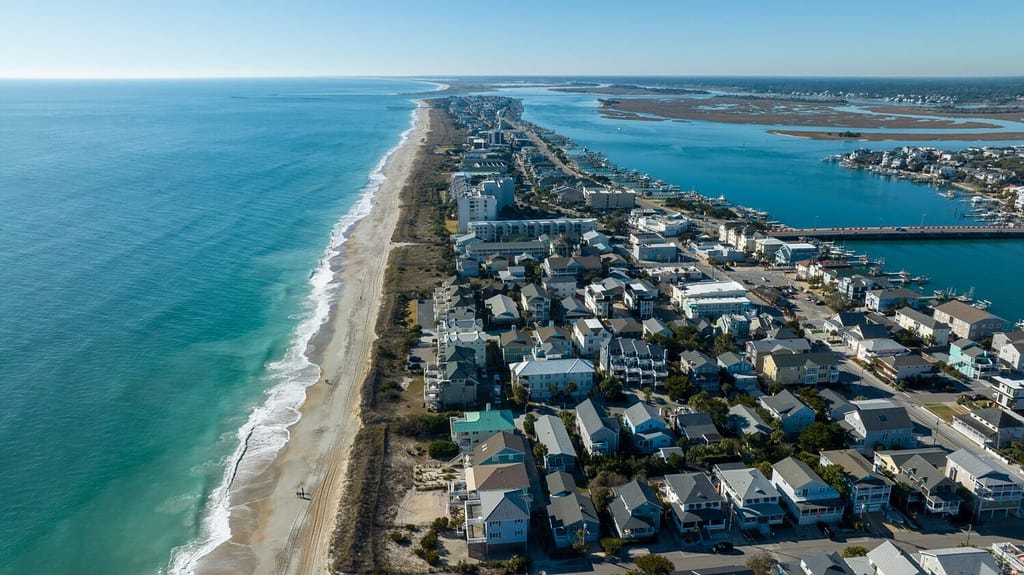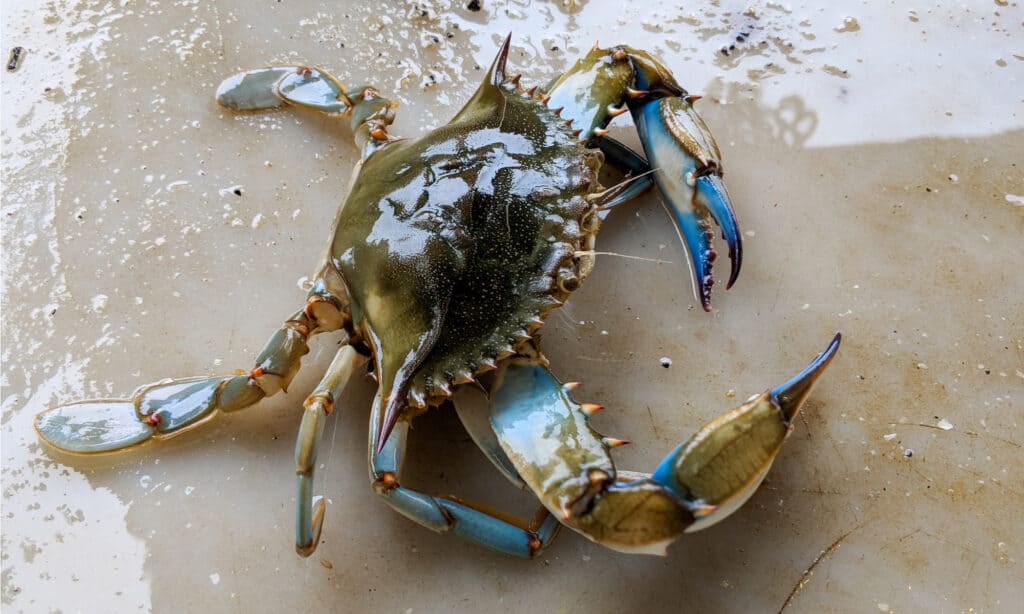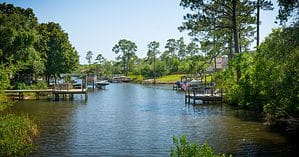The Pamlico Sound is an important lagoon along the North American East Coast. It plays an essential role in human activities, as well as the ecology of the region. Today, we are going to take a look at this sound and learn all we can about it. Let’s discover: How deep is the Pamlico Sound? Plus, a whole lot more!
How Deep is the Pamlico Sound?

Although open ocean, the Pamlico Sound is extremely shallow.
©Katrina Wriglesworth/Shutterstock.com
The Pamlico Sound is generally between 5-6 feet on average but has a maximum depth of 23 feet.
The Pamlico Sound is a unique nautical region, primarily due to just how shallow this large area is. Most of the sound is only 5 to 6 feet deep, which means you can see the bottom easily (provided there isn’t a lot of sediment). The deepest part of the sound is only 23 feet deep, which is still much shallower than the ocean. The shallow water also means that the sound can change quickly with the wind and the weather. Since the Pamlico Sound is fed by the Tar, Neuse, Pamlico, and Trent Rivers and is already so shallow, the water level can rise or decrease by two feet in a few hours.
This rather shallow expanse causes some problems for larger boats and sea vessels that try to enter the region. Getting stuck in shallow water with nothing else around for miles is a recipe for trouble.
Just How Big is the Pamlico Sound?
The Pamlico Sound is not only the largest lagoon on the East Coast of the United States but also one of the largest in the world. When combined with the nearby connected network of other sounds, the region covers an area of about 3,000 square miles. It measures bigger than the state of Delaware and is the second-largest estuary in the United States, only behind Chesapeake Bay. Pamlico Sound stretches for 80 miles from Roanoke Island to Cedar Island and is 15 to 30 miles wide.
The Pamlico Sound is part of a larger system of estuaries. The system includes Albemarle Sound, Currituck Sound, Croatan Sound, Roanoke Sound, Bogue Sound, Back Sound, and Core Sound. The other sounds that connect to the Pamlico Sound vary in size and shape. The Albemarle Sound is the second largest sound in the system and connects to the Pamlico Sound by the Roanoke Sound and the Croatan Sound.
The Currituck Sound is the northernmost sound in the system, and a narrow strip of land separates it from and is separate from the Albemarle Sound. The Croatan Sound is a narrow channel that connects the Roanoke Sound and the Albemarle Sound. The Roanoke Sound is a small sound that lies between Roanoke Island and Bodie Island (part of the Outer Banks region). The Bogue Sound is a long and narrow sound that runs parallel to the coast for about 25 miles north of Emerald Isle. It is separated from the ocean by Bogue Banks. The Back Sound is a small sound that lies between Harkers Island and Shackleford Banks. The Core Sound is located to the south of the Pamlico Sound. It is separated from the ocean by Core Banks.
Where is the Pamlico Sound?

Located in North Carolina, the Pamlico Sound is an important feature for the people and wildlife nearby.
©Red Lemon/Shutterstock.com
The Pamlico Sound is located in the state of North Carolina, on the eastern coast of the United States. The sound is part of the Outer Banks. The Outer Banks is a chain of islands that separate the sound from the Atlantic Ocean. It’s home to the famous television show and often abbreviated OBX. The sound lies between the mainland of North Carolina and the Outer Banks islands.
The Pamlico Sound is bordered by several counties and towns in North Carolina. On the mainland side, the sound is bordered by Hyde, Beaufort, Craven, Carteret, and Dare counties. Some of the towns that are located along the sound are Belhaven, Washington, New Bern, Oriental, Morehead City, and Manteo. On the island side, the sound is bordered by Dare and Carteret counties. The island features towns including Nags Head, Kill Devil Hills, Kitty Hawk, Rodanthe, Avon, Buxton, Hatteras, Ocracoke, and Atlantic.
The Pamlico Sound is also near several national parks and wildlife refuges. Each tries to preserve some of the region’s rare and essential ecology. Locations include:
- Cape Hatteras National Seashore
- Cape Lookout National Seashore
- Pea Island National Wildlife Refuge
- Alligator River National Wildlife Refuge
- Swanquarter National Wildlife Refuge
- Mattamuskeet National Wildlife Refuge
- Cedar Island National Wildlife Refuge
The Ecology of the Pamlico Sound

Blue crab is one of the most important commercial industries on the Pamlico Sound.
©P. Dorman/Shutterstock.com
Calling the Pamlico Sound “important” to the region would be quite an understatement. The Sound is not only a large and shallow waterway but also one of the most diverse ecosystems along the east coast, supporting unique and extremely rare wildlife only found there. For example, the sound is home to a variety of fish, shellfish, birds, and mammals that depend on the salt water and the marshes, seagrasses, and oyster reefs that grow along the sound. Additionally, it also provides a habitat for migratory birds that stop by or nest along the coastal waters.
Some shellfish you may find in the Pamlico Sound are blue crabs, shrimp, oysters, and clams. Among fish in the sound are flounder, red drum, speckled trout, striped bass, and even dolphins. These species are valuable for commercial and recreational fishing. Additionally, their presence helps maintain the health and balance of the ecosystem. Some of these species also serve as prey for larger predators, such as sharks. Sharks are common in the Pamlico Sound, especially in the summer months. Some of the shark species seen in the sound are Atlantic sharpnose, blacktip, bull, hammerhead, lemon, sandbar, and tiger sharks. Sharks play an important role in controlling the populations of other fish species.
Birds that live in the Pamlico Sound are pelicans, terns, gulls, ducks, geese, and swans. These birds feed on fish, crabs, insects, plants, and seeds that they find in the water or on the shore. Of these birds, some are year-round residents of the sound, while others are seasonal visitors or migrants. Some of the birds that migrate within the sound include tundra swans, snow geese, Canada geese, pintails, mallards, black ducks, green-winged teal, and blue-winged teal. Other migratory birds may be gadwalls, wigeons, shovelers, scaups, buffleheads, mergansers, loons, grebes, cormorants, herons, egrets, ibises, and sandpipers. These birds use the sound as a resting spot while they cover huge distances during migrations.
Aside from animals, the sound is an important source of food, income, and recreation for North Carolina residents. For instance, 90%, or roughly an annual $100 million, of the state’s commercial fishing income ties directly tied to the Pamlico Sound.
The Pamlico Sound is a complex and dynamic ecosystem that deserves our respect and care. It is one of the great waters of the east coast of America and a natural wonder of the world.
Activities on the Pamlico Sound
Due to the unique “waterscape” and shallow nature of the Pamlico Sound, the region is one of the east coast’s best places for watersports. Some of the common activities include kayaking, sailing, and kiteboarding. Additionally, fishing is a huge attraction for the region. Fishermen flock to the sound for potential catches of crabs, shrimp, oysters, and the world’s largest species of red drum.
Additionally, there are numerous lighthouses, historical monuments, cultural sites from the Pamlico American Indians, and more to explore.
Thank you for reading! Have some feedback for us? Contact the AZ Animals editorial team.







